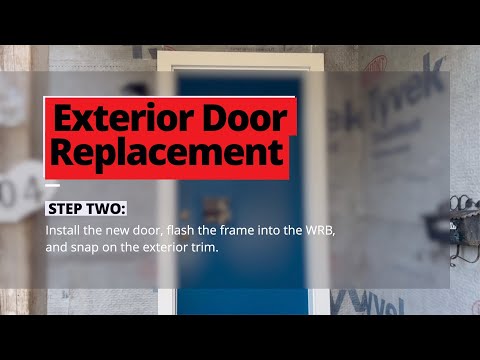There is more to an airtight watertight door installation than flashing; adjusting the weatherstripping is critical
The first step in exterior door installation is to check the floor to see if it is level. If it is not, make it level with either a belt sander or some sort of shimming strategy.
Next, cross-string the opening to see if the walls are aligned. Sometimes the bottom of one side can get moved during construction.
In this case, the wall is straight.
Rigid sill pans collect water and direct it out
While Max winds his string, John D quizzes the crowd about sill pans.
Are you all familiar with rigid sill pans? It's a hard piece of plastic you put in there and its meant to divert the water back out.
So any water that gets back under the door, hits the back dam of the sill pan and it kicks it back around and out.
We'll basically be sealing that sill pan to ther threshold, and the bottom leg of the jamb so that no water can get in from that area.
He's going up the side jambs a couple of inches, and running three generous beads all the way across the sill and up the other leg.
See, now we can be assured with this rigid sill pan that nothing's going to get in there, there's no chance of a leak.
Seal the top edge of the sill pan with a bead of sealant. In the video, the opening was flashed by the WRB installers, but in animation land, we’re going to do it now.
Flashing tape should bridge the WRB, wall sheathing, and rough framing.
Head flashing overlaps jamb flashing and now we’re ready to install the door.
Almost.
One last bead of sealant is applied to the upturned back dam of the sill pan so the door threshold can bed into it.
Install the door, plumbing the hinge side in both directions
Now we can install the door.
John D:
So when you look at this jamb, it's thick on one side, on the exterior side, and its thin on the insode. Now. most guys will bury their screws behind the weatherstripping on the thin side. The problem with that is that ypu're going through the thinnest part of the door jamb, and obviously, there's a chance it might not hold up as well, so we'd really prefer you to screw through the thicker part of the door jamb.
Max Potts: And that will always be on the opposite side of the hinges. so it doesn't matter if it is an inswing door or an outswing door, the think part of the jamb will be opposite the hinge side.
John D: So what Max has done, is he has drilled a series of countersunk holes with an 1/8th inch bit in three locations, approximately where the hinges are.
The only other thing I'd say is to inspect the door, it may have a plug in it—if you have a plug, you have to take it out now, otherwise, it's really hard to take out.
They lift the door into the opening, dropping it into the pan and standing it up.
Max partially drives a screw to hold the door in place, but also to anchor it plumb, in both directions.
With the door where it should be, he slides shims in next to the partial screws to snug the door frame into the opening.
With the shims in place, Max checks the door for plumb and John checks his notes for jokes.
No jokes.
Max: And now we're going to screw down the hinge side all of the way
So he snugs the partial screws into the frame. Beginning with the middle screw, then the top and bottom. He points out to make sure that you are drilling
Max: ...with an actual drill and not (looks over at John D) just making noises with your mouth, and make sure that you're still in plumb.
John D: So now we're going to do the strike jamb
Max: Because we have this door siull is level and out hinge side is plumb, in both directions, so the door should open now. Now, with the door anchopred, we will look for weatherstripping compression.
When we close this door, we want to make sure that it compresses the weatherstripping to a proper amount and that will keep air and water out. So I'm going to back this screw out from the strike jamb, and that allows me to mob=ve this strike side jamb in or out to get the correct compression.
So he closes the door, and pulls it tight against the weatherstripping, and sets the screws again.
Adjust the jamb and sill to correctly compress ther weatherstripping
With the jamb side done, he runs a three-inch screw through each hinge to fully anchor the door in the wall.
The strike plate adjusts to fine tune the weatherstripping compression and then Max turns to the threshold adjustments.
You should be able to pull a dollar bill through the weatherstripping at the bottom of the door, but it shouldn’t be too snug.
The screws allow you to adjust the threshold up or down slightly to dial in the tightness.
With the threshold adjusted, trim the excess weatherstripping and tuck it back into place in the jamb. The sticky the foam gasket is the last piece of the puzzle out here. First lay a little bed of sealant at the base, pull the weatherstripping back, and slip the gasket into place.
At the demonstration house, we could swivel the wall around to address the inside air sealing -- Wait, What?
But in the real world, you usually need to walk to the other side of the wall.
Inside, apply a light bead of spray foam deep into the wall cavity, tight to the exterior trim. It should not need to squeeze out the back like in this illustration.
Go around the top and both sides.
Now, the door is locked tight, airtight, and watertight.
And that’s what you missed at the ProTradeCraft’s Demo House.
—This video is part of a series of videos shot at the 2019 International Builders' Show in the Professional Builder Show Village onstage at ProTradeCraft's Demonstration House. See all of the videos here.











